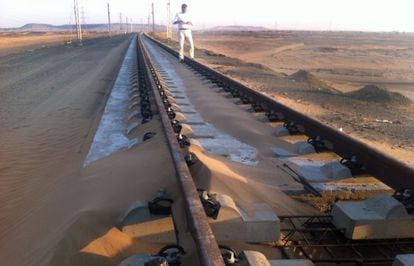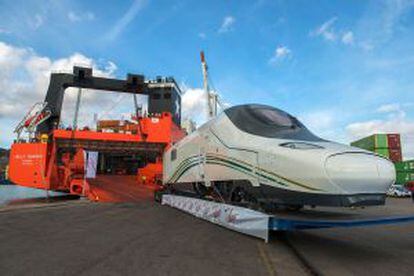Saudis kick up storm over Spanish group’s high-speed desert rail project
Minister’s letter brings to light the problems threatening the €6.7bn Medina-Mecca AVE line

Saudi Arabian authorities have issued a stark warning to the Spanish consortium building the €6.7-billion AVE high-speed rail link between Medina and Mecca, which is suffering significant delays.
In December, just weeks after being appointed in a cabinet reshuffle, the kingdom’s new transportation minister, Abdullah bin Abdulrahman al-Muqbel, issued a public statement calling on the consortium to speed up work or risk having the contract rescinded.
Muqbel, a former mayor of Riyadh who oversaw the construction of the city’s subway system, later reiterated his message in a tough letter to the Spanish group, which is made up of 12 companies, including rail infrastructure manager Adif, train builder Talgo and construction companies OHL and FCC.
The consortium, which sources say has been riven by internal divisions and “lacks leadership,” held an emergency meeting on December 26 to discuss the letter.
Once completed, the Haramain High Speed Rail Project will carry Muslim pilgrims and other passengers between the holy cities of Mecca and Medina. The 450-kilometer route also crosses the port city of Jeddah, on the Red Sea.
Sources say the Spanish consortium of 12 companies has been riven by internal divisions
The Spanish group, which signed the contract three years ago, is expected to build the rail track and supply 35 high-speed trains in time to inaugurate the line in December 2016.
Sources say Saudi Arabia wants to discuss the ongoing problems with a single representative: “Nobody is picking up the phone,” says one engineer, adding that the Saudi authorities want the president of the consortium, Pablo Vázquez, the CEO of state railway company Renfe, to go.
In turn, the consortium blames its Saudi partners for the delays. “They have been causing delays, so we don’t know what the calendar is any more. They can say that we were supposed to have finished phase 4 by June 2015, but if you don’t give me the stretch until April, then it’s going to be difficult to meet that date. That’s the argument. How much time do I give you? For each month of delay, do you give me a month more? We now need a calendar that takes into account the delays in handing over the land,” says a senior figure in the consortium. Government sources say the delays are not the fault of Spanish companies.
“The Saudis are insisting that the final delivery date of December 2016 is met,” says another senior figure in the consortium. “That means that we’re going to have to run like madmen. We still haven’t got them to recognize that there have been delays in handing over the land. And there are serious penalty clauses for delay. For an Arab, the contract is the starting point in negotiations, not the end point. We have been negotiating with them for three years and this has caused a lot of headaches.”

The engineering teams say they are under constant pressure from the two firms supervising the work, German consultancy DB International and Saudi Arabia’s Dar Al-Handasah. “The role of this company is crucial,” says one engineer. “It is judge and jury. It is doing the engineering work on Phase 1 and then supervises us on Phase 2. By crucifying us, it justifies its mistakes and shortcomings, as well as washing its hands of the delays.” Local company Bin Laden is responsible for Phase 1: Spanish companies say it benefits from delays because it runs a bus company that transports pilgrims from Medina to Mecca.
Added to the problems from conflicts of interest and in-fighting are the practical difficulties of building a high-speed train line in the desert, such as how to counter the damage caused by sandstorms and the continual advance of the dunes, as well as sharp fluctuations in temperature, which can range from 50ºC in the day to -2ºC at night.
The Spanish consortium’s original bid included the construction of a five-meter-high wall alongside some stretches of the track. Around half of the total route runs across sandy plains, which are considered the most dangerous areas. Only five percent is dunes. Over the summer, the prevailing winds move the sands around 50 meters.
In the more dangerous areas, Spanish engineers have built the track on concrete slabs, which makes it easier to clean, but is more expensive than laying tracks on top of stone ballast. Some engineers in the consortium say much more track than predicted will have to be laid on slabs, which will significantly increase costs. Some slab sections have been built on raised embankments up to 10-meters high, which has never been done before for high-speed track, and there are concerns that they may not be stable.
But even where track is laid on concrete slabs, the sand has to be kept at bay. A team from Ineco, another member of the consortium, has recommended building walls downwind, because in winter, the prevailing winds vary and can take sand in previously unforeseen directions. So far, the team’s recommendations have been ignored.
Spain has some experience of building rail lines in the desert, having constructed a 100-kilometer stretch of track in its former territory of Western Sahara to transport phosphates. In the 1970s, to try to stem the advance of the dunes, fuel oil was poured on to sand adjacent to the track, and walls and ditches were built. But the man who oversaw that project doubts the solution that has been chosen by Spanish engineers in Saudi Arabia will work. “The wall and ditch solution is fine in theory. But once you have stopped the sand and it is in the ditch, what do you do with it? We’re talking about millions of tons a year. Where do you take it? I might be wrong, but I doubt these walls and ditches will work without ruining the project.”
A board member from the consortium accepts there will be cost overruns and that doubts about how to deal with the sand and the climate exist: “We don’t have solutions. We have read everything there is about the subject, and there is nothing, but our engineers are very good, and they will find a way. In the meantime, we will have to clean the track of sand every night.”
In response to the very public criticism from the Saudis, the consortium has decided to close ranks and avoid any leaks. “This consortium can be frustrating sometimes, because everything gets out. Journalists ask questions, and people like to talk, and there are 12 of us. That is a lot of people to manage. A secret between 12 people isn’t a secret,” says one board member. During the December meeting Pablo Vázquez suggested imposing a €500,000 fine on companies that talked to the media off-the-record. The idea was discarded.
Around half of the total route runs across sandy plains, which are considered the most dangerous areas
Aside from agreeing to a vow of silence, the consortium decided that the best way to placate the Saudis was to name a new interlocutor after the previous incumbent was sacked in November. “They get burned out,” says one board member. The new man will be Santiago Ruiz González, the deputy director general at FCC, and the company’s Middle East director. Ruiz worked on the Riyadh metro during the time that al-Muqbel was mayor of the city.
Over recent months, a number of senior figures in companies involved in the consortium have abandoned the project, unable or unwilling to stand the working conditions and pressures. “Sometimes we just have to send people off to the Emirates or Dubai to have a beer and watch a movie, because this is very hard,” says one CEO.
The problems emerging now have been building up for some time, and date back several years. In 2007, under the Socialist Party government of José Luis Rodríguez Zapatero, there were two Spanish teams bidding for the project. “Two Spanish offers was not a good idea. Besides which, two state companies, Renfe and Adif, were in competing consortiums,” says a source from the government of the time. Of the six short-listed candidates, two were Spanish, and the rest were French, German, Japanese, and Italian. All had local partners, usually related to different branches of the Saudi royal family.
In the event, Spain put forward just one candidate, but made up of 12 partners. Aside from giants like Renfe and Adif, or consultants Ineco, there were rivals such as OHL and Cobra, along with minnows such as Imathia, only set up in 2004.
How did things reach this point? “Because of politics. Without politics, nobody would have dreamed of a consortium of 12 companies. The Saudis have used this to their advantage because they are very good negotiators. They play one off against the other, and talk directly to the companies. They have benefited from our weakness,” says one board member. None of the other foreign consortiums competing with Spain had more than four companies.
This consortium can be frustrating sometimes, because everything gets out. A secret between 12 people isn’t a secret” Consortium board member
“In Saudi Arabia, any major business deal is done through relationships. If you don’t know somebody high up, it’s not going to work,” says an expert who works in a Spanish business school. “The first thing is to find a powerful lobby. It is clear that the former king, Juan Carlos, played a big role in this, and that his long-standing friendship with the Saudi royal family was fundamental. These relationships have to be maintained: you have to have tea with them every now and then.” Juan Carlos traveled to Saudi Arabia at the end of January.
Even if the route is open by December 2016 – the Saudis are pressing for it to be ready by the summer of that year – Spain’s problems will only be starting. The consortium has agreed to manage a line for 12 years that is due to handle around 60 million passengers annually. Spain’s own national AVE network carried a record 29.6 million people in 2014. “We’re talking about a train every four minutes. Like in Japan! And we’ll have to manage separate carriages for men and women. Agreeing to manage a route for 12 years is a huge risk for public companies like Adif and Renfe,” says one board member, pointing out that private companies involved in the construction will make their money, but that turning a profit from operating the line, which will fall to Renfe and Adif, will be a much more difficult enterprise.
“This marvelous project could end up being a white elephant,” says one former engineer on the project already quoted, explaining that when the kings of Siam were unhappy with one of their subjects, they would send him a white elephant, a sacred animal. The recipient would then be obliged to look after it, and allow anybody who wanted to venerate it to do so. They often ended up broke.










































